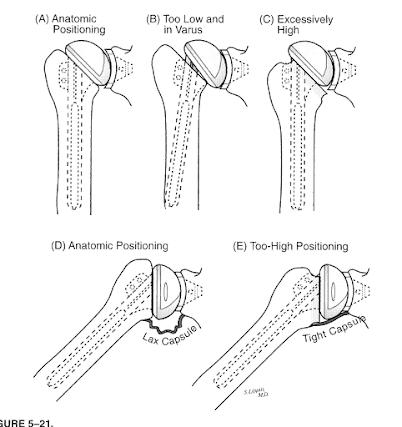These authors sought to determine if there is an association between a shift in humeral center of rotation (COR) from ideal in anatomic TSA with respect to patient-reported outcomes and range of motion (ROM).
Offset of the center of rotation (COR) from ideal was measured on postoperative radiographs using a best-fit circle technique.
The circle was constructed so that it touched each of the following landmarks: lateral cortex of the greater tuberosity, medial edge of the greater tuberosity and inflection point of the medial calcar.
A second circle was then drawn matching the curvature of the prosthetic head implant.
The prosthetic humeral head diameter was then measured on each radiograph, and used to normalize the COR measurements by multiplying by the ratio of the actual prosthetic head diameter divided by the measured diameter.
The direction of COR change from ideal was recorded (superior-medial, superior-lateral, inferior-medial, inferior-lateral).
A near perfect prosthetic center of rotation is indicated by an overlap of the ideal and the prosthetic best fit circles (A). The normalized distance between the prosthetic and ideal COR (red line) was recorded for each patient (B).
87 patients aged 65.6 ± 8.3 years, 59% male, with mean 3.2 years follow-up were included in this study.
A COR change of >2.7 mm was a significant predictor of below-average ASES scores following TSA (sensitivity: 79%, specificity: 72%, p <0.001).
The number of patients achieving a patient acceptable symptomatic state (PASS) was also investigated. PASS was achieved in 100% of patients with 0-2 mm, 90% of patients with 2-4 mm, and 56% of patients with over 4 mm of COR increase.
The forward flexion averaged 152 for COR <2.7 and 139 for COR >2.7.
The change in active forward flexion averaged 41 for COR < 2.7 and 26 for COR > 2.7,
Comment: The authors concluded that restoration of ideal humeral center of rotation during anatomic TSA is challenging and significant shifts are common.
A prosthetic COR shift > 2.7 mm from ideal is associated with worse patient reported outcomes and ROM following anatomic TSA.
In 64% of cases the COR was > 2 mm from ideal and in 18% of cases it was > 4 mm, indicating that surgeons had difficulty in matching the COR's.
The primary direction of COR shift was superior-medial (76%), with inferior-medial (11%), inferiorlateral (9%) and superior-lateral (3%) much less common.
The authors suspected that a too-high head cut with subsequent overstuffing was a common cause of COR shift.
The concept of overstuffing was introduced over 25 years ago in the book Practical Evaluation and Management of the Shoulder . The authors found that the amount of stuffing from the humeral component is determined by both the geometry of the component and the position in which it is placed. "A component inserted excessively high tightens the capsule as the arm is elevated (similar to a mechanical cam) and limits the range of elevation." "A component inserted into varus disproportionately stuffs the joint when the arm is at the side."
When the joint is overstuffed, the amount of torque the muscles must apply is increased, resulting in decrease active elevation.
A useful intraoperative reference is the "berm", i.e. the medial edge of the proper neck cut; the lateral aspect of the prosthetic humeral articular surface should be positioned just below it.
Follow on twitter: https://twitter.com/shoulderarth
Follow on facebook: https://www.facebook.com/frederick.matsen
Follow on LinkedIn: https://www.linkedin.com/in/rick-matsen-88b1a8133/
How you can support research in shoulder surgery Click on this link.
Here are some videos that are of shoulder interest







